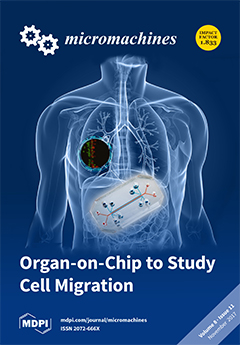To determine the degree of cancer cell killing after treatment with chemotherapeutic drugs, we have developed a sensitive platform using localized surface plasmon resonance (LSPR) and aptamers to detect the extracellular cytochrome-
c (cyto-
c), a mitochondrial protein released from cancer cells
[...] Read more.
To determine the degree of cancer cell killing after treatment with chemotherapeutic drugs, we have developed a sensitive platform using localized surface plasmon resonance (LSPR) and aptamers to detect the extracellular cytochrome-
c (cyto-
c), a mitochondrial protein released from cancer cells for the induction of apoptosis after treatment, to evaluate the effectiveness of cancer therapy. In this assay, a short single-stranded 76-mer DNA aptamer with a unique DNA sequence, which binds towards the cyto-
c like an antibody with a high binding affinity and specificity, was conjugated to gold nanorods (AuNR) for LSPR sensing. Practically, cyto-
c was first grabbed by a capturing antibody functionalized on the surface of micro-magnetic particles (MMPs). Subsequently, the AuNR-conjugated aptamer was added to form a complex sandwich structure with cyto-
c (i.e., (MMP-Ab)-(cyto-
c)-(AuNR-aptamer)) after washing away the non-target impurities, such as serum residues and intracellular contents, in a microfluidic chip. The sandwich complex led to formation of AuNR aggregates, which changed the LSPR signals in relation to the amount of cyto-
c. With the LSPR signal enhancement effects from the AuNRs, the detection limit of cyto-
c, sparked in human serum or culture medium, was found to be 0.1 ng/mL in our platform and the whole sensing process could be completed within two hours. Moreover, we have applied this assay to monitor the apoptosis in leukemia cancer cells induced by a potential anti-cancer agent phenylarsine oxide.
Full article






